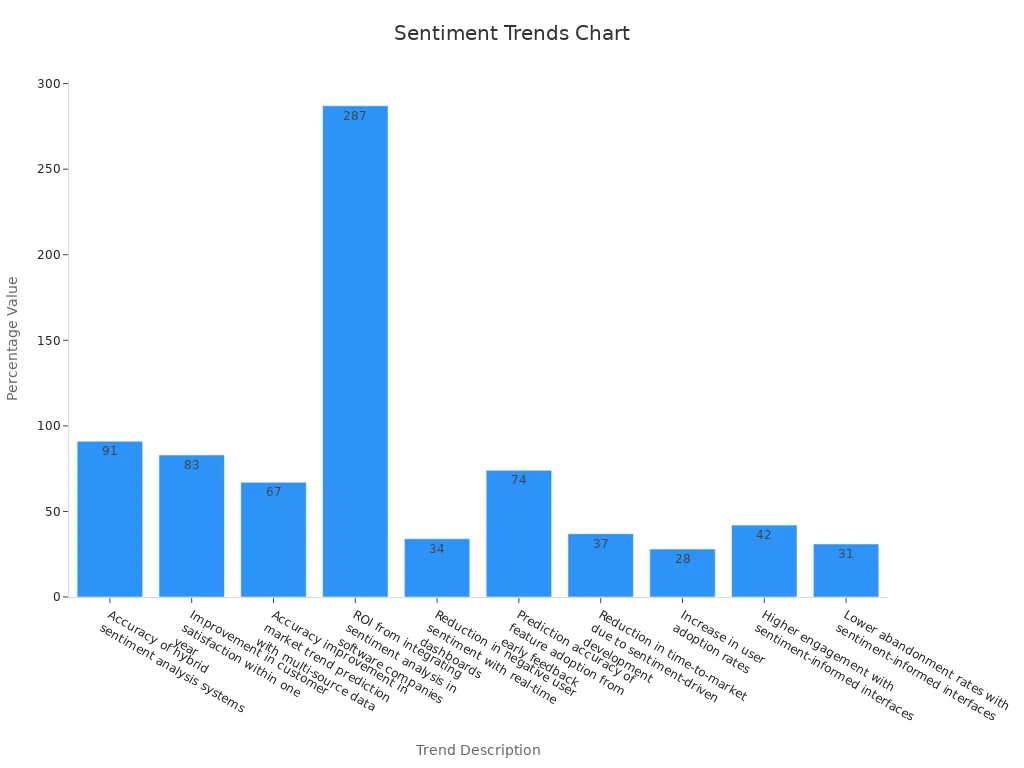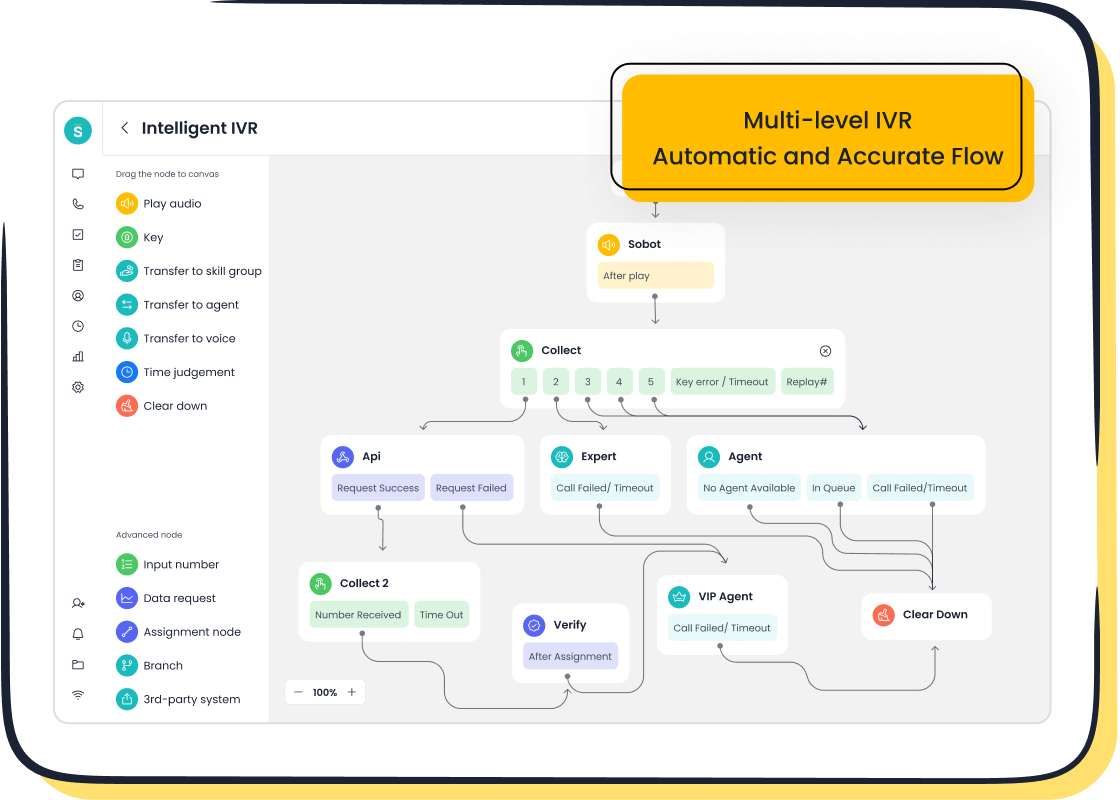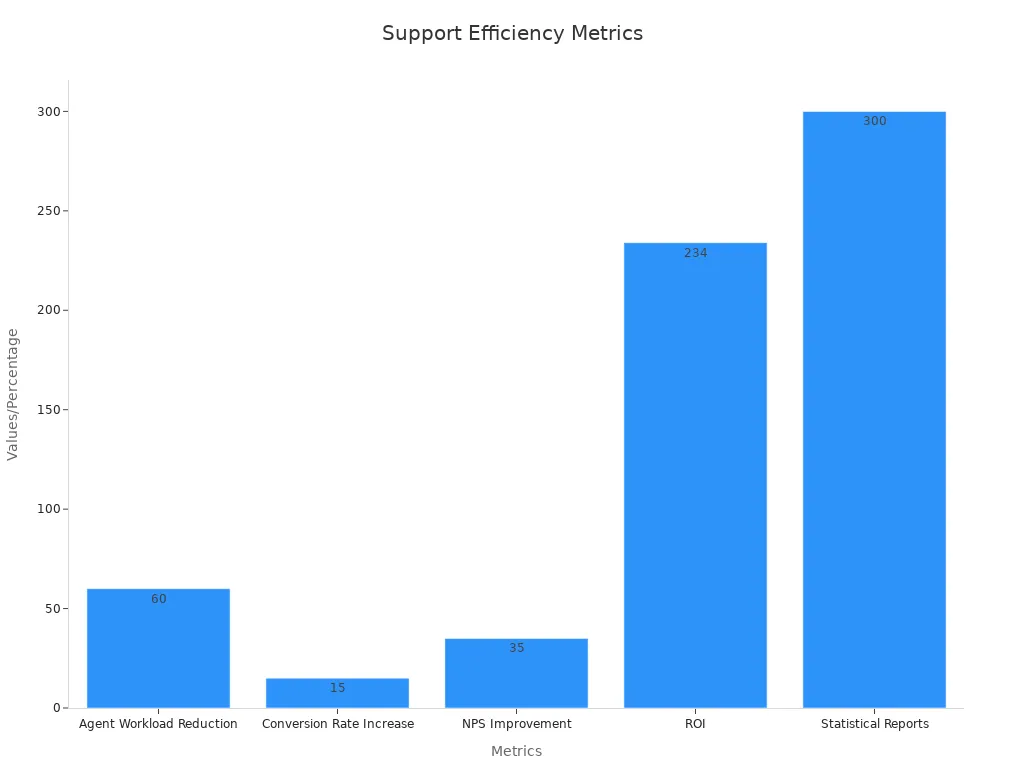What You Should Know About Customer Service Sentiment Analysis

Customer service sentiment analysis uses artificial intelligence to detect emotions in customer interactions, helping businesses unlock actionable insights. Companies in retail, e-commerce, and enterprise services use this technology to improve customer experience and support quality. For example, businesses that analyze customer sentiment see a 51% reduction in resolution times and a boost in customer satisfaction scores from 68 to 82. Sentiment analysis for retailers also helps identify urgent issues and route calls faster. Sobot and Sobot AI deliver real-time sentiment analysis, empowering organizations to understand customer needs and drive actionable insights across every customer service channel.
Customer Service Sentiment Analysis
What It Means
Customer service sentiment analysis uses artificial intelligence to understand how customers feel during interactions. This process involves analyzing customer feedback, support tickets, call transcripts, and social media posts. The technology classifies each message as positive, negative, or neutral. It also detects emotions like happiness, frustration, or anger. Companies use machine learning and natural language processing to make this possible. These tools help businesses see the real feelings behind customer words.
Sentiment analysis goes beyond simple word checks. It uses advanced models, such as Support Vector Machine (SVM) and Long Short-Term Memory (LSTM), to find patterns in customer feedback. These models can spot sarcasm, cultural context, and even subtle changes in tone. Real-time sentiment analysis tools monitor live chats, calls, and social media, giving companies instant insights. This helps them respond quickly to customer needs.
Note: Sentiment scoring assigns a number to each customer interaction. This allows companies to track changes in customer sentiment over time and compare results across different channels.
Customer sentiment analysis also includes multimodal analysis. This means it looks at voice tone, written words, and sometimes even facial expressions. By combining these sources, businesses get a complete picture of customer sentiment. This process helps companies understand what customers like, dislike, or expect from their service.
Why It Matters
Customer sentiment analysis plays a key role in modern customer service. It helps companies improve support, build trust, and stay ahead of competitors. By analyzing customer sentiment, businesses can spot problems early and fix them before they grow. This leads to better customer experiences and stronger relationships.
Published data shows that companies using real-time sentiment analysis see a 40% increase in customer satisfaction scores and a 35% boost in retention rates. In e-commerce and financial services, real-time personalization driven by sentiment analysis increases conversion rates by 20-30%. AI-powered emotion detection in call centers can reduce handle times by 50%, allowing agents to solve issues faster and more effectively.
Companies like Nike and WatchShop use sentiment analysis to monitor social media and online reviews. This helps them understand public opinion and improve their products and services.
Industry surveys highlight the benefits of sentiment analysis:
- It helps manage online reputation by responding quickly to negative feedback.
- It provides marketing insights by analyzing both numbers and written comments.
- It guides product development by finding out what customers want.
- It supports competitor analysis and tracks industry trends.
- It improves employee engagement by measuring internal sentiment.
- It offers real-time insights during live events and streams.
The following table shows key trends in customer sentiment analysis adoption:
| Statistical Trend Description | Statistic / Percentage |
|---|---|
| Accuracy of hybrid sentiment analysis systems | Up to 91% accuracy |
| Improvement in customer satisfaction within one year | 83% of companies report improvement |
| Accuracy improvement in market trend prediction with multi-source data | 67% more accurate |
| ROI from integrating sentiment analysis in software companies | 287% over three years |
| Reduction in negative user sentiment with real-time dashboards | 34% reduction within six months |
| Prediction accuracy of feature adoption from early feedback | 74% accuracy |
| Reduction in time-to-market due to sentiment-driven development | 37% faster |
| Increase in user adoption rates | 28% increase |
| Higher engagement with sentiment-informed interfaces | 42% higher engagement |
| Lower abandonment rates with sentiment-informed interfaces | 31% lower abandonment |


Sobot provides advanced tools for customer sentiment analysis. Its Voice/Call Center and AI solutions use real-time data from calls, chats, emails, and social media. Sobot’s platform helps companies measure customer sentiment, track changes, and respond quickly to issues. This leads to higher customer satisfaction and better business outcomes. Sobot’s technology supports multilingual sentiment analysis, making it valuable for global brands.
Analyzing customer sentiment helps companies:
- Improve customer service by understanding emotions and needs.
- Reduce churn by identifying unhappy customers early.
- Enhance marketing and product strategies with data-driven insights.
- Build stronger customer relationships and loyalty.
Customer service sentiment analysis is now essential for any business that wants to succeed in a competitive market. Companies that invest in these tools see faster response times, better support quality, and higher customer satisfaction.
Customer Sentiment in Support
Measuring Emotions
Measuring customer sentiment in support means understanding how customers feel during every interaction. Companies use AI tools to analyze words, tone, and even pauses in conversations. This process gives support teams emotional insights that help them see if a customer feels happy, frustrated, or confused. For example, Sobot’s Voice/Call Center uses real-time sentiment analysis to track emotions in calls and chats, making it easier for agents to respond quickly.
Research shows that measuring customer sentiment during support calls predicts how customers will act in the future. One study looked at over 25,000 call center conversations and found that matching the agent’s emotions with the customer’s emotions leads to higher satisfaction. Real-time emotion tracking lets agents fix problems before they get worse. The Verint blog explains that speech analytics can spot negative emotions right away, giving teams a chance to turn a bad moment into a positive one.
Companies like Butternut Box and Deliverr use AI-powered sentiment analysis to gather emotional insights from many channels. They find out what customers like or dislike and use this information to improve service. Measuring customer sentiment helps teams focus on urgent cases and solve common problems faster.
Impact on Experience
Customer sentiment shapes the entire support experience. When companies track sentiment, they can see which moments matter most to customers. Positive customer sentiment leads to loyalty, more spending, and good reviews. Negative sentiment often causes customers to leave after just one or two bad experiences.
The Emotional North Star concept helps companies pick one key emotion to focus on, such as trust or happiness. For example, Hagerty insurance measured happiness and found it increased customer loyalty. The U.S. Department of Veteran Affairs measured trust and saw better engagement and even life-saving results. These examples show that measuring customer sentiment and emotional insights can guide teams to create better experiences.
Sobot’s AI solutions help companies measure customer sentiment across calls, chats, and emails. By using these tools, support teams can spot trends, fix issues early, and make every customer feel valued. Measuring customer sentiment is not just about numbers; it is about understanding feelings and using emotional insights to improve every support interaction.
How Customer Sentiment Analysis Works

AI and NLP Technologies
Artificial intelligence (AI) and natural language processing (NLP) form the backbone of modern sentiment analysis. These technologies help computers understand human language and emotions. AI models, such as large language models like Google Gemini and ChatGPT, can process unstructured data from customer conversations. They detect patterns, tone, and intent in messages, making it possible to identify positive, negative, or neutral sentiment.
A MarTech article explains that AI-powered sentiment analysis goes beyond counting words. It uses advanced algorithms to find subtle cues in customer feedback. In healthcare, for example, generative AI models like GPT-3 analyze patient comments to improve engagement and streamline data management. These same methods apply to customer sentiment analysis in retail, e-commerce, and service industries. Data governance and compliance remain important when using these tools, ensuring that customer information stays secure and private.
Sobot uses AI and NLP in its Voice/Call Center and AI solutions. The platform analyzes calls, chats, emails, and social media messages. This approach helps companies understand customer emotions and respond with empathy.
Data Sources in Sobot Voice/Call Center
Sobot’s Voice/Call Center collects data from many channels. The system gathers information from phone calls, live chats, emails, and social media. Each channel provides unique insights into customer sentiment. For example, call recordings reveal tone and pauses, while chat logs show word choice and typing speed.
Sobot’s unified workspace brings all this data together. Agents see a complete view of each customer’s history and sentiment. The platform uses AI-powered voicebots to analyze speech in real time. It also tracks written feedback from tickets and emails. By combining these sources, Sobot delivers a full picture of customer sentiment across every touchpoint.
Note: Multimodal analysis helps Sobot detect emotions more accurately by looking at both voice and text data.
Real-Time Insights
Real-time sentiment analysis gives support teams instant feedback during customer service interactions. Sobot’s platform monitors conversations as they happen. It assigns sentiment scores to each interaction, alerting agents to frustration or satisfaction right away.
Companies benefit from these real-time insights in several ways:
- Vodafone reduced customer churn by 20% by detecting unhappy customers early.
- Support teams prioritize urgent cases, leading to faster response times. Studies show that 68% of customers who get a reply within an hour are more likely to return.
- Automated alerts help teams fix problems quickly, preventing lost sales and improving the customer experience.
Sentiment analysis tools like those from Sobot enable continuous feedback loops. Teams can measure improvements in Net Promoter Score (NPS) and customer satisfaction. Real-time insights help agents prepare for sensitive conversations and deliver more empathetic support. This approach leads to higher retention and business growth.
Real-time sentiment analysis transforms customer support by allowing companies to act on emotions as they happen, not after the fact.
Implementing Sentiment Analysis with Sobot
Getting Started
Sobot makes it easy for any business to begin using sentiment analysis. The platform supports companies in retail, e-commerce, and enterprise services. Sobot provides a user-friendly interface that helps teams start collecting feedback from every customer interaction. The system works across calls, chats, emails, and social media. With Sobot, companies can use customer feedback tools to gather opinions and measure satisfaction. The platform’s visual bot builder allows even non-technical staff to set up workflows for analyzing feedback. This helps teams understand customer needs and emotions from the very first day.
Integration Steps
Sobot offers a smooth integration process for sentiment analysis. The platform includes an SDK that supports web chat, mobile apps, and messaging platforms. Teams can connect Sobot to their existing CRM systems, creating a unified workspace for all customer data. Real-time analytics and reporting tools help monitor customer sentiment as it happens. The robust API lets developers extend features and automate tasks. Sobot’s system supports multi-language engagement, making it ideal for global brands. Intelligent routing directs customer inquiries to the right agent, improving response times and satisfaction. By integrating Sobot, companies can track every customer touchpoint and respond quickly to urgent cases.
Tip: Sobot’s customizable workflows and automation features help streamline support operations and improve the customer experience.
Best Practices
To get the most from Sobot’s sentiment analysis, companies should follow proven strategies:
- Set clear goals for customer sentiment analysis and train teams on new tools.
- Use automation for high-volume and repetitive tasks to save time.
- Track key metrics like first response time, resolution time, and customer satisfaction scores.
- Balance automation with personal service by allowing easy escalation for complex issues.
- Review customer feedback and performance data often to refine workflows.
Sobot’s platform helps companies adapt their approach over time. By focusing on both automation and personal touch, businesses can build stronger customer relationships and improve loyalty.
Benefits and Use Cases

Improving Support Quality
Companies use customer sentiment analysis to improve support quality in many ways. They analyze customer interactions like emails, chats, and phone calls to detect frustration or impatience. User behavior, such as rage clicks or drop-offs, also shows negative sentiment. Surveys at different stages of the customer journey collect both numbers and opinions, tracking changes in sentiment over time. Interviews and social media listening reveal how customers truly feel, even when they do not tag the company. Online review sites provide more sentiment data by analyzing positive and negative words in customer feedback.
- Companies identify customer expectations and fix problems quickly.
- Automated tools tag sentiment and track behavior, helping teams segment customers and measure impact.
- Sobot’s Voice/Call Center uses these methods to personalize support and increase customer satisfaction.
Customer sentiment analysis helps companies optimize user experience and build loyalty by addressing issues as soon as they appear.
A table of real-world examples shows how sentiment analysis improves support quality:
| Company | Impact of Sentiment Analysis | Result |
|---|---|---|
| Glammmup | Mapped customer sentiment to CSAT scores. | CSAT improved from 68 to 82. |
| Scandinavian Biolabs | Used sentiment insights to coach agents and improve products. | 50% drop in negative sentiment drivers. |
| James Villas | Automated urgent ticket triage using sentiment tagging. | 51% faster resolution for urgent issues. |
| Lakrids by Bülow | Improved packaging after analyzing negative sentiment. | 26% fewer packaging complaints. |
Reducing Churn
Customer sentiment analysis helps companies reduce churn by spotting unhappy customers early. Gartner reports that companies using sentiment-driven programs see a 25% drop in churn rates. Forrester found a 10% decrease in churn and a 15% rise in customer satisfaction when companies use sentiment analysis in their strategies. Advanced analytics let teams act before customers leave, leading to higher retention.
- Companies track customer sentiment to find at-risk customers.
- Real-time alerts help teams respond quickly and prevent churn.
- Sobot’s AI solutions provide these insights, supporting proactive customer recovery.
| Metric | With Sentiment Analysis | Without Sentiment Analysis |
|---|---|---|
| Customer Retention | 25% higher retention rate | Reactive damage control |
| Customer Satisfaction | 15-20% improvement | Flat or declining |
| Escalation Management | 40% faster resolution | Manual review, delayed response |
Sentiment analysis enables early detection and intervention, which leads to measurable reductions in churn and boosts positive customer sentiment.
Enhancing Agent Performance
Advanced sentiment analysis tools help agents perform better by giving real-time feedback and guidance. These tools detect rising customer agitation, measure empathy, and provide live prompts. Agents resolve calls 15% faster and receive early warnings that reduce escalations by 20%. Multimodal sentiment scoring across voice and text improves customer satisfaction by 10%.
- Companies use customer sentiment to coach agents and plan resources.
- Key metrics include response time, engagement rates, and first call resolution.
- Sobot’s platform analyzes all customer feedback, delivering unbiased and fast insights for agent training.
Monitoring customer sentiment across all channels helps agents improve, leading to better customer satisfaction metrics and stronger customer relationships.
Challenges and Considerations
Accuracy and Language
Customer sentiment analysis faces several challenges with accuracy and language. Many studies show that language complexity, slang, and mixed languages can confuse even advanced AI models. For example, sarcasm and idioms often hide the true meaning behind a customer’s words. Sentiment models sometimes struggle with negations, such as “not bad,” which actually means something positive. Detecting these patterns requires special training and large datasets.
The following table highlights common challenges and solutions in customer sentiment analysis:
| Challenge | Description | Proposed Solution |
|---|---|---|
| Idioms | Idioms can hide emotions and confuse models. | Train neural networks to map idioms to emotions. |
| Negations | Negatives and double negatives can flip the meaning of a sentence. | Use large datasets with many negation examples. |
| Comparative Sentences | Comparisons may not show clear sentiment. | Use knowledge graphs to understand context. |
| Multilingual Analysis | Different languages need unique tools; direct translation can lose meaning. | Build language-specific models and train them for each language. |
Research shows that hybrid deep learning models, such as BERT-CNN-BiLSTM-Att, improve accuracy in customer sentiment classification. However, even these models can struggle with noisy data from social media or product reviews. Customer sentiment analysis tools like Sobot’s AI platform use advanced models and multilingual support to address these issues, but ongoing research continues to improve results. Studies also highlight that class imbalance, such as too many neutral comments, can reduce accuracy. Techniques like oversampling help balance the data and improve predictions.
Detecting sarcasm and mixed emotions remains a challenge for customer sentiment analysis, but new models and larger datasets are making progress.
Data Privacy
Data privacy is a top concern in customer sentiment analysis. Companies must protect customer information and follow strict rules. Regulations like GDPR and CCPA require businesses to get consent before using customer data and to keep that data secure. Many customers worry about how their information is used. In fact, 83% of consumers feel concerned about sharing personal data online, and 72% would stop buying from a company if they felt their privacy was at risk.
Key privacy practices include:
- Anonymizing sensitive customer information in all datasets.
- Getting clear consent from customers before using their feedback.
- Following local and international data protection laws, such as GDPR, CCPA, and industry-specific rules like HIPAA.
- Providing privacy notices that explain how customer data is used and stored.
- Updating policies as technology and regulations change.
Sobot’s platform supports secure data handling and compliance, helping companies build trust with their customers. Transparent data practices and strong privacy controls not only meet legal requirements but also increase customer loyalty. Studies show that 92% of people appreciate having control over their data, and 83% are willing to share information for better service if privacy is respected. Companies that prioritize privacy in customer sentiment analysis stand out in the market and maintain long-term trust.
Customer service sentiment analysis drives business growth and loyalty by enabling real-time interventions, tracking trends, and revealing what matters most to customers. Companies using Sobot’s Voice/Call Center and AI solutions gain actionable insights that improve support quality and efficiency. Sobot’s platform reduces agent workload by 60%, boosts conversion rates, and delivers fast resolutions.
- Real-time sentiment monitoring increases satisfaction and loyalty.
- Personalization based on sentiment data leads to more repeat business.
- Actionable insights help teams make data-driven decisions.

| Metric | Result/Value | Description/Impact |
|---|---|---|
| Agent Workload Reduction | 60% | Less stress for agents, more efficient support |
| NPS Improvement | 35% | Higher customer satisfaction and loyalty |
| ROI | 234% | Strong financial return from Sobot’s solutions |
Companies ready to start can explore Sobot’s resources and request a demo to see how actionable insights transform customer support.
FAQ
What is customer service sentiment analysis?
Customer service sentiment analysis uses AI to detect emotions in customer interactions. Companies use it to understand if customers feel happy, frustrated, or neutral. Sobot’s platform analyzes calls, chats, and emails to help businesses improve support quality and customer satisfaction.
How does Sobot perform customer service sentiment analysis?
Sobot uses AI and natural language processing to analyze customer conversations in real time. The system reviews voice, chat, email, and social media data. Sobot’s unified workspace gives agents instant insights, helping them respond quickly and improve customer experiences.
Why is customer service sentiment analysis important for businesses?
Customer service sentiment analysis helps companies spot unhappy customers early. Research shows that businesses using sentiment analysis see up to a 25% drop in churn rates. Sobot’s solutions help teams act fast, leading to higher retention and better support outcomes.
Can customer service sentiment analysis work in multiple languages?
Yes, customer service sentiment analysis can support many languages. Sobot’s platform offers multilingual sentiment analysis, making it ideal for global brands. This feature helps companies understand customer emotions worldwide and deliver consistent support.
Is customer data safe when using customer service sentiment analysis?
Sobot follows strict data privacy rules, including GDPR compliance. The platform encrypts all customer data and requires consent before analysis. Companies using Sobot can trust that customer information stays secure and private.
Tip: For more details on Sobot’s security and compliance, visit the official website.
See Also
Best Voice of Customer Tools Reviewed and Ranked
Ten Guidelines for Selecting Social Media Support Software
Ten Ways To Improve Customer Satisfaction With Live Chat
